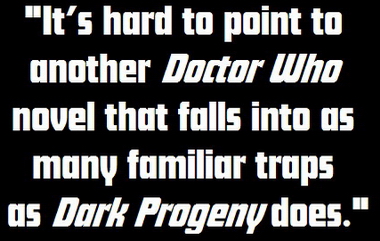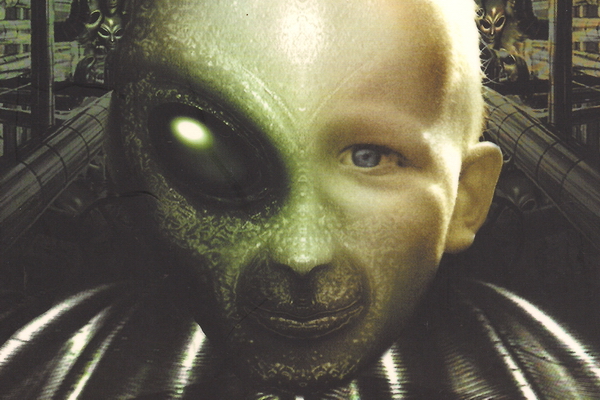|
| |
|
STORY PLACEMENT THIS STORY TAKES PLACE BETWEEN THE
NOVELS "THE SLOW CITY OF THE DEAD."
WRITTEN BY STEVE EMMERSON
RECOMMENDED PURCHASE OFFICIAL BBC 'EIGHTH DOCTOR' PAPERBACK (ISBN 0-563-53837-6) RELEASED IN AUGUST 2001.
BLURB Ceres Alpha is being developed. ITS surface crawls with gigantic city-machines that ARE PREPARING IT FOR THE colonisation THAT
IS
TO follow. biosphere-engineering WorldCorp is finding things more difficult than he would like. The whole project seems to be falling apart under an ever- increasing burden of
mysteries. strange babies been born with telekinetic powers? Why won't the terraforming go according to plan? AND Why are they experiencing EVER more problems with the systems that run
the
city-machines? answer. A mysterious infiltrator known only as the Doctor. |
|
|
Dark Progeny AUGUST 2001
Dark Progeny - the embodiment of the difficult second album. Few writers have impressed me more with a debut novel than Steve Emmerson did with Casualties of War, but such accomplishment gives rise to great expectations, and even fewer writers are able to live up to them when asked to deliver a second tome. Regrettably Emmerson can’t count himself amongst their number as, in his precipitous attempt to prove that he wasn’t a one-book wonder, he ended up strongly suggesting otherwise.
It’s hard to point to another Doctor Who novel that falls into as many familiar traps as Dark Progeny does. Whilst one could argue that a story capable of being shot in a grey-walled studio and a disused quarry helps to capture the spirit of the television series, it invariably feels like a waste when the printed word offers no budgetary boundaries. Similarly, unless it serves the plot, there is no good reason to sideline companions for great swaths of the narrative. On television, a week’s holiday for Patrick Troughton often meant that the Doctor needed twenty-five minutes or so’s concussion, but in print I feel that the companions should not only be utilised but explored. Dark Progeny does neither with either.
storyline – a calamitous string of hackneyed conceits and derivative set pieces. We have the Doctor posing as medical Doctor whom he’s been mistaken for; a villainous corporation conducting illegal and amoral experiments; another planet that’s not only alive, but threatened by the humans who are ransacking its resources; hell, Emmerson even wheels out the mind probe… and in deadly earnestness too.
This is a real pity as, conceptually, Dark Progeny had massive potential. The fundamental idea, which is encapsulated superbly by Black Sheep’s harrowing cover illustration (above), is one so grim and grotesque that it should have been one of most disturbing Doctor Who stories ever told. Telekinetic mutant infants who’ve been whisked away from their parents at birth, hidden away and then experimented upon? Children so powerful, deadly and full of rage that they won’t even stay dead, rising from the soil of the planet that ensouled them in order to seek retribution against their would-be killers? Quarry or no, they could never have pulled that off on the telly - not while Mary Whitehouse had a breath left in her battered old frame anyway.
However, the book’s moments of terror are all too ephemeral and are ultimately drowned by the carnival of conventions and clichés. Reading it again for the purposes of this review, the only cold moments that left an impression of me were those carried by Veta and Josef, who at the start of the novel are told that their baby has been stillborn, only to later find that he did not perish but was taken away and experimented upon. The author does a very effective job of getting us inside the mother’s head as she swings from anguish to anger and back again. Everything else here is generic and forgettable though, and if I didn’t know better I’d swear that it hadn’t been penned by the same man that put his name to Casualties of War.
It’s now been a little over nine years since Dark Progeny saw
print, and a little over nine years since we last heard from its author.
It’s tempting to infer the obvious from the lack of any further Doctor
Who commissions, but to be honest I hope that this doesn’t prove to be
Emmerson’s final offering. His first novel was so extraordinary that one
can’t fault his zeal when it came to following it up, even if that
follow-up proved to be as disappointing as Dark Progeny did. And
now, having had the best part of a decade to ferment some new ideas,
there’s probably a novel waiting to get out of this feller that would
rival or even surpass his first. Here’s hoping that one day someone
lets it.
|
|
|
Copyright © E.G. Wolverson 2010
E.G. Wolverson has asserted his right under the Copyright, Designs and Patents Act, 1988 to be identified as the author of this work. |
|
|
Unless otherwise stated, all images on this site are copyrighted to the BBC and are used solely for promotional purposes. ‘Doctor Who’ is copyright © by the BBC. No copyright infringement is intended. |
|

.jpg)
.jpg)
 Worst
of all though is Emmerson
Worst
of all though is Emmerson